Disassembly
Note: Disassembly using a gearbox-side engine stand is described below. If another type of stand is used, please take into account the difference in operation, etc.
1. Remove the engine and transmission assembly from the vehicle and separate the transmission from the engine. See section «Complete engine».
2. Remove the cover and clutch disc. See chapter Clutch.
3. Remove the flywheel (on models with manual gearbox) or master disk (on models with automatic transmission).
Lock the flywheel or drive plate (1) holder (special tool: KV11105210) (A) and unscrew the fixing screws.
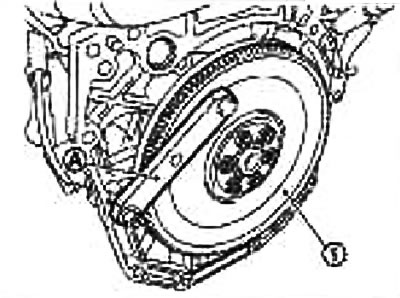
Loosen the mounting bolts using the TORX head (size E20).
Caution: Do not damage or scratch the drive disc (on models with automatic transmission) and the contact surface for the clutch disc on the flywheel side.
4. Lift the engine with a winch and place it on a stand.
Attention: Use a stand with sufficient load capacity (about 150 kg or more), capable of supporting the weight of the engine.
If the load capacity of the stand is insufficient, remove the following components in advance to reduce the risk of the stand tipping over:
- the top of the intake manifold; see section «upper intake manifold»;
- an exhaust manifold; see section «An exhaust manifold»;
- valve cover; see section «Valve lid»;
Note: The figure shows an example of a universal engine stand on the gearbox side with the flywheel or drive plate removed.
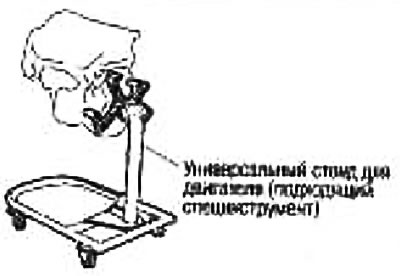
Attention: Before removing the chains, make sure that the stand is stable and there is no risk of it tipping over.
5. Drain engine oil. See chapter Lubrication system and engine cooling system.
6. Drain the engine coolant by removing the plug (1) from the drain hole in the engine.
7. Remove the cylinder head. See section «Removal and installation».
8. Remove the oil pan (upper and lower). See section «Oil pan and coarse oil filter».
9. Remove the knock sensor.
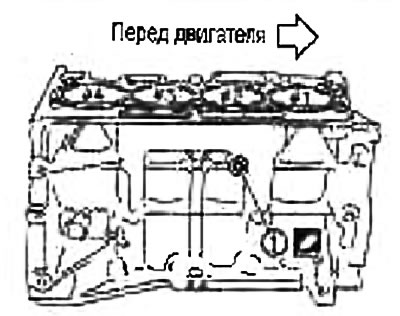
Attention: Handle the sensor carefully, avoiding shock.
10. Remove the cover and then the crank angle sensor (POS).
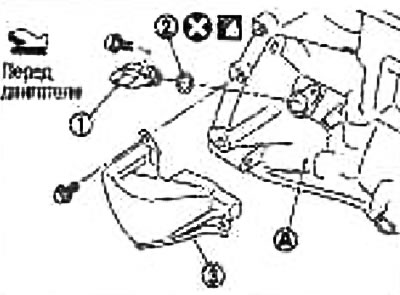
1. Crank angle sensor (POS)
2. O-ring
3. Lid
A. Cylinder block on the left side
Attention:
- Handle the deliverer with care, do not drop or hit it.
- Do not disassemble the sensor.
- Avoid getting metal powder on the magnetic part of the probe tip.
- Do not leave the sensor in a place where they can be affected by magnetism.
11. Remove the guide bush (1) with a puller (special tool: ST16610001) (A) or suitable tool (on models with automatic transmission).
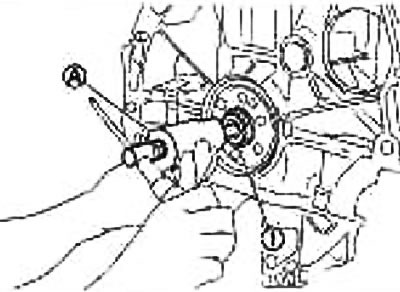
Note: There is no guide bush on models with manual gearbox.
12. Remove connecting rods and piston assemblies as follows:
Before removing the connecting rods and piston assemblies, check the connecting rod side clearance. See section «Connecting rod side clearance».
- A. Bring the crankpin of the connecting rod to be removed to BDC.
- b. Remove the big end cap.
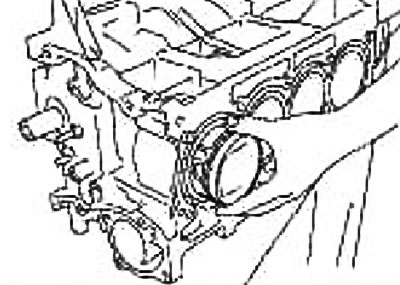
- With. Push the connecting rod and piston assembly toward the cylinder head with a hammer handle or similar tool.
Attention:
- Do not damage the contact surface with the connecting rod bearing cap.
- When removing the large connecting rod head, be careful not to damage the cylinder walls and the connecting rod journal.
13. Remove bearings from a rod and a cover of bearings of a rod.
Attention: When removing, make notes on the position of their installation and put them in order without mixing them.
14. Remove piston rings from pistons.
Check the piston ring backlash before removing the piston rings. See section «Piston ring side clearance».
Use a piston ring expander (suitable special tool).
Attention: Do not damage the piston when removing the piston rings. Do not spread the piston rings too wide - they may break.
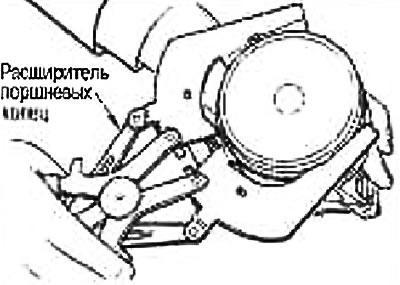
15. Remove the piston from the connecting rod.
Press out the piston pin using a stand and a press.
The following special tool is used:
- Stand: ST13030020
- Punch: KV10109730
- Center cap: KV10110310
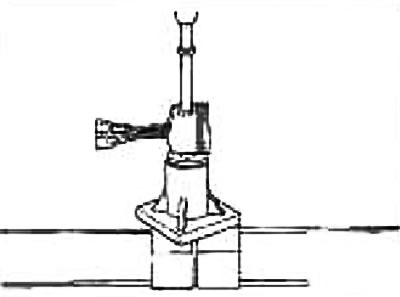
Attention: Be careful not to damage the piston and connecting rod.
Note: The piston pin has a press fit in the connecting rod.
16. Remove the main bearing caps as follows:
Before loosening the main bearing cap bolts, measure the crankshaft end play. See section «Axial play of the crankshaft».
- A. Loosen and turn out the bolts in several passes in the reverse order shown in the figure.
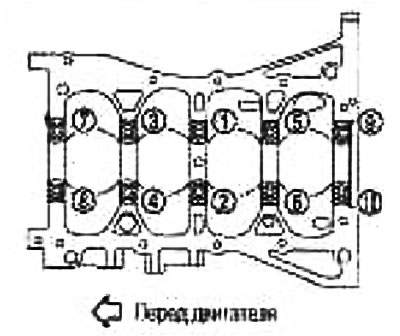
TORX socket can be used (size E14)
- b. Remove the main bearing caps by lightly tapping with a plastic mallet.
17. Remove the crankshaft (2)
Attention:
- Do not damage or deform the signal disc (1), mounted on the crankshaft.
- When laying the crankshaft on the floor, place a block of wood so that the signal disc does not touch the floor surface.
- Remove the signal disc only if necessary.
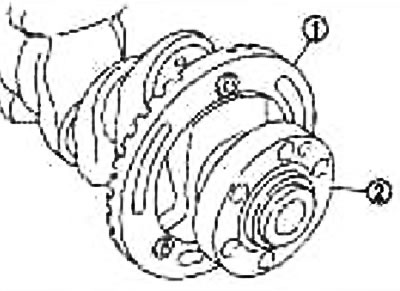
Note: When removing and installing signal disc, use TORX socket (size: E40).
18. Remove the rear oil seal from the rear end of the crankshaft.
19. Remove the main (upper and lower) and thrust bearings from the cylinder block and remove the main bearing caps.
Attention: When removing, make notes on the position of their installation and put them in order without mixing them.
Assembly
1. Blow out the coolant passages, oil passages, cylinders and crankcase with compressed air and remove foreign particles from them.
Caution: Wear protective goggles.
2. Screw in the plug (1) into the drain hole of the cylinder block as shown.
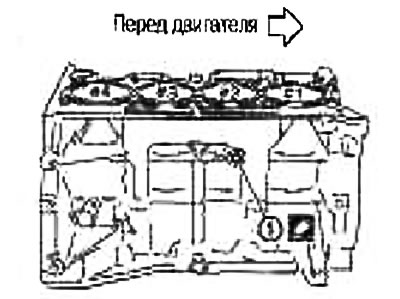
Use branded sealant or equivalent.
Tightening torque: 9.8 Nm (1.0 kg m)
3. Install the main and thrust bearings as follows:
- A. Remove dust, dirt and oil from the contact surfaces under the bearings in the cylinder block and from the main bearing caps.
- b. Install thrust bearings on both sides of journal #3 (IN) in the cylinder block.
Install thrust bearings with oil groove (A) towards the crank arm (outside).
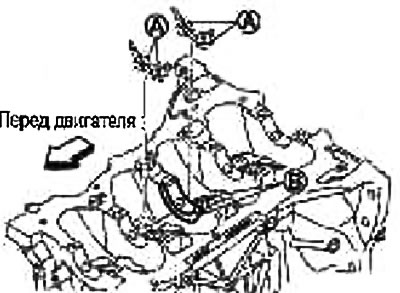
- With. Install main bearings (1), observing the installation direction.
Install main bearings with lubrication holes (A) into the cylinder block, and bearings without them - into the main bearing caps.
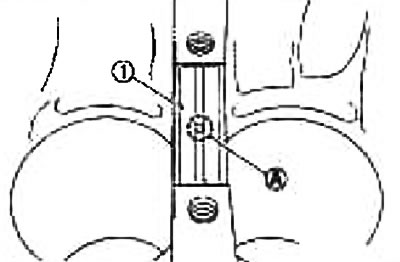
Before installing the main bearings, apply fresh engine oil to the bearing surfaces (from within). Do not apply oil on the reverse side, but wipe it thoroughly.
Make sure the oil holes in the cylinder block line up with the holes in the corresponding bearing.
Install the main bearings as shown in the illustration.
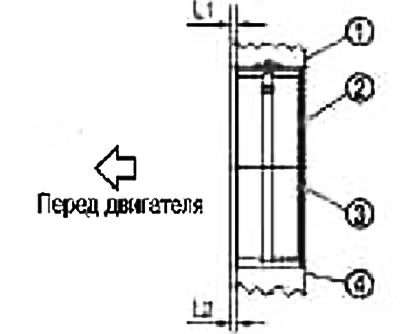
1. Cylinder block
2. Main bearing (upper)
3. Main bearing (lower)
4. Main bearing cap
Note: Center the main bearings to the specified dimensions. During repairs, the central position can be checked visually.
| Neck position | №1 | №2 | №3 | №4 | №5 |
| L1 | 1.65-2.05mm | 1.25-1.65mm | 2.30-2.70mm | 1.25-1.65mm | 1.60-2.00mm |
| L2 | 1.30-1.70mm | 1.30-1.70mm | 2.30-2.70mm | 1.30-1.70mm | 1.30-1.70mm |
Attention: Size «L1» neck #3 is the distance from the end of the base of the neck body (jumpers) (and not the distance from the end face of the thrust bearing).
4. If the signal disc was removed (1), install it on the crankshaft.
- A. Install signal disc (1) from the reverse side of the crankshaft flange towards the counterweight (towards the front of the engine).
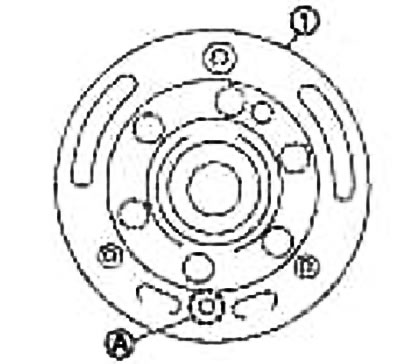
A. Dowel pin hole.
- b. After installing the crankshaft and signal plate, use the dowel pin to tighten the bolt.
Note: Crankshaft locating pin and signal disc are included.
- With. Remove the dowel pin.
Note: Remember to remove the dowel pin.
5. Install the crankshaft in the cylinder block.
Turn the crankshaft by hand and make sure it turns freely.
Caution: Do not install the rear oil seal yet.
6. Install the main bearing caps.
Focus on the front mark (IN) and neck number marking (A).
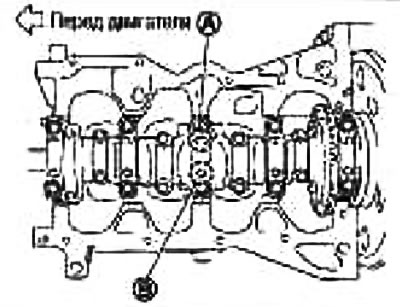
Note: The cylinder block and main bearing caps are made in one piece. They can only be replaced as a set.
7. Tighten the bolts of the main bearing caps in the order indicated by the numbers in the figure, as follows:
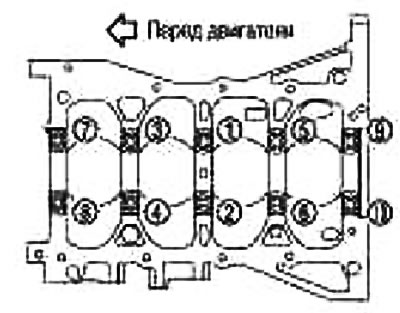
- A. Apply fresh engine oil to the threads and seating surface of the mounting bolts.
- b. Tighten the main bearing cap bolts.
Torque:32.4 Nm (3.3 kg m)
- With. Tighten 60°clockwise (corner tightening) in the order indicated by the numbers in the figure.
Attention: Check the tightening angle with a protractor wrench (special tool: KV10112100) (A). Avoid judging by eye without the use of tools.
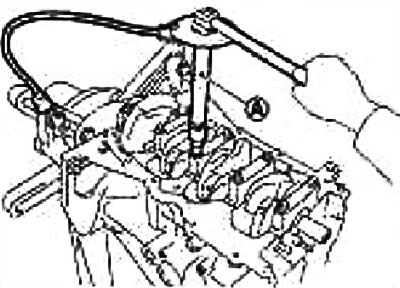
After tightening the mounting bolts, turn the crankshaft by hand and check that it rotates freely.
Check crankshaft end play. See section «Axial play of the crankshaft».
8. Install the connecting rods into the pistons as follows:
- A. Assemble the piston and connecting rod so that the front mark (A) on the piston crown and Ns cylinder (WITH) on the connecting rod were located, as shown in the figure.
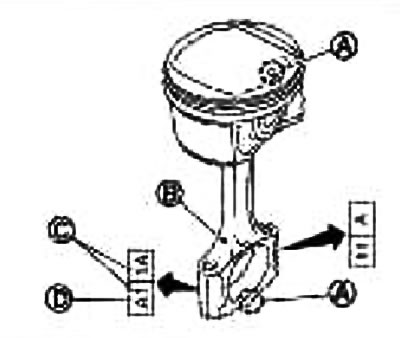
B. Oil hole
D. Big End Class
Note: Symbols without deciphering are a correction code.
- b. Press in the piston pin using a stand (special tool).
The following special tool is used:
- Stand: ST13030020
- Spring: ST13030030
- Punch: KV10109730
- Central shaft: KV10114120
- Center cover: KV10110310
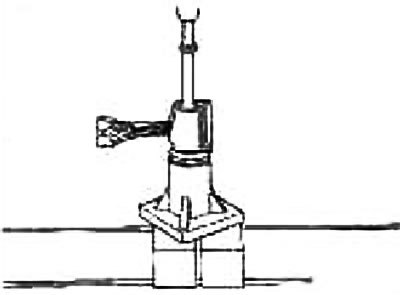
Attention: Press in so as not to damage the piston pin.
Note: The piston pin has a press fit in the connecting rod.
Press in piston pin (2) piston side «A» to a depth of 2.35 mm.
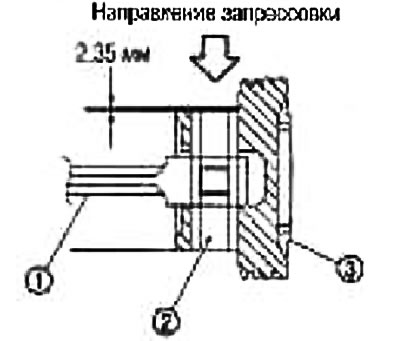
1. Connecting rod
After installation, make sure the piston (3) mix freely.
9. Install the piston rings with an expander (suitable special tool).
Attention:
- When installing the piston rings, do not damage the piston.
- Do not spread the piston rings too wide - they may break.
Position the piston ring locks relative to the piston front mark (IN), as it shown on the picture.
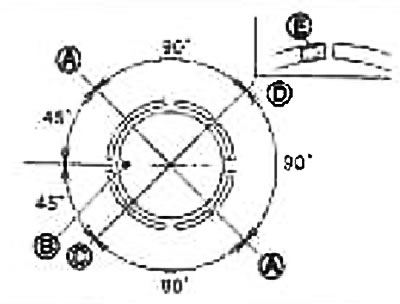
A. The joint of the upper or lower scraper of the oil scraper ring (any of them)
C. Joint of the second compression ring, joint of the oil scraper ring, spacer ring
D. Upper compression ring joint
Install the second compression ring with the embossed marking (E) up.
Marking: Second compression ring: «R»
10. Install bearings in connecting rods and caps.
When installing connecting rod bearings, apply fresh engine oil to the bearing surfaces (domestic). Do not apply oil on the reverse side, but wipe it thoroughly.
Install the bearing in the center.
Note: There is no stopper lug on the bearing.
Make sure the oil holes on the connecting rod line up with the holes in the corresponding bearing.
Install the connecting rods according to the dimensions shown in the figure.
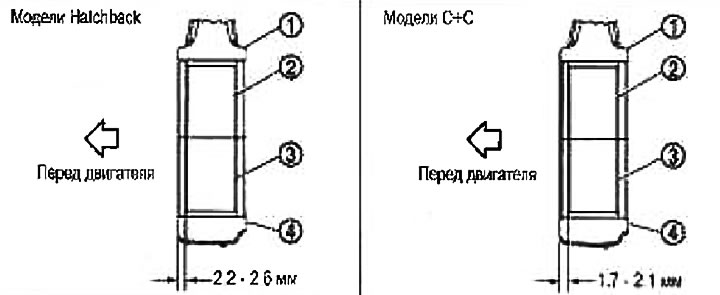
1. Connecting rod
2. Connecting rod bearing (upper)
3. Connecting rod bearing (lower)
4. Connecting rod bearing cap
Note: Install the connecting rod bearing in the center according to the dimensions shown in the figure. During repairs, the central position can be checked visually.
11. Install the connecting rods and piston assemblies to the crankshaft.
Bring the crankpin of the connecting rod to be installed to BDC.
Apply a sufficient amount of fresh engine oil to the cylinder walls, piston and crankpin.
Check the number of the cylinder to which the connecting rod corresponds.
Using a piston ring compressor (special tool: EM0347000Q) (A) or a suitable tool, insert the piston with the front mark on the piston crown towards the front of the engine.
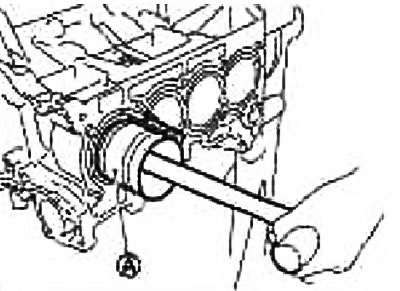
Attention:
- Do not damage the contact surface with the connecting rod bearing cap.
- When inserting the large connecting rod head, be careful not to damage the cylinder walls and the connecting rod journal.
12. Install the connecting rod bearing cap.
Before installation, check if the marking of the cylinder number matches (WITH), embossed on the connecting rod, markings on the cover.
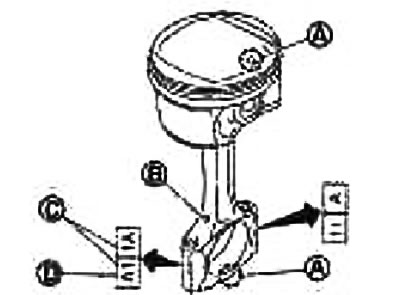
A. Front mark
B. Oil hole
D. Big End Class
13. Check the outside diameter of the connecting rod bolts. See section «Outer diameter of connecting rod bolts».
14. Tighten the connecting rod mounting bolts as follows:
- A. Apply fresh engine oil to the threads and seating surfaces of the connecting rod bolts.
- b. Tighten the connecting rod bolts.
Tightening torque: 27.5 Nm (2.0 kg m)
- With. Fully loosen the bolts to 0 Nm (0 kg m)
- d. Tighten the bolts in several passes.
Tightening torque: 19.6 Nm (2.0 kg m)
- e. Turn all bolts 60°clockwise (corner tightening)
Warning: Use a protractor wrench (special tool: KV10112100) (A). Avoid judging by eye without the use of tools.
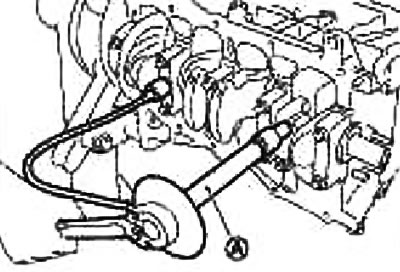
After tightening the bolts, check that the crankshaft rotates freely.
Check the side clearance of the connecting rod. See section «Connecting rod side clearance».
15. Install the oil pan (upper). See section «Installation».
Install the rear oil seal after installing the oil pan (top).
16. Press in the rear oil seal. See section «Installation».
17. Install flywheel (on models with manual gearbox) or master disk (on models with automatic transmission).
When installing the flywheel (on models with manual gearbox) or master disk (on models with automatic transmission) on the crankshaft, align the dowel pin on the crankshaft side with the pin hole on the flywheel/drive plate side.
Install the drive (1), amplifying disc (2) and guide bush (3), as it shown on the picture (on models with automatic transmission).
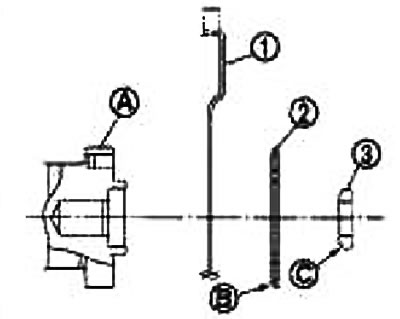
A. Rear end of the crankshaft
B. Rounding
S. chamfer
Attention: Observe the direction of installation (relative to the front and back).
Using a drift with a diameter of 33 mm, press the guide sleeve onto the end of the crankshaft until it stops (on models with automatic transmission).
Tighten the bolts as follows:
- Fix the crankshaft from turning with the holder (special tool; KV11105210).
- Tighten the mounting bolts crosswise in several passes.
18. Install knock sensor (1).
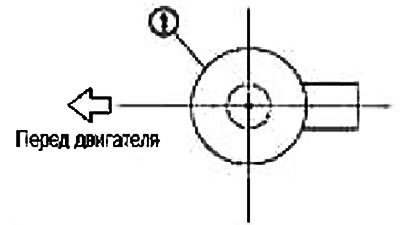
Install the sensor with connectors towards the rear of the engine.
Attention:
- Do not tighten the bolts while holding the connector.
- If you hit or dropped the knock sensor, replace it with a new one.
Note:
- Make sure that there are no foreign particles on the contact surface of the cylinder block and the rear surface of the knock sensor.
- Make sure the knock sensor does not interfere with other parts.
19. Install the crankshaft angle sensor (POS).
Tighten the bolts making sure the sensor is fully seated in the mounting hole.
20. When installing the dipstick guide (1) fix the plot (IN), shown in the figure, on the inlet pipe (A), by inserting the guide on the side of the cylinder block.
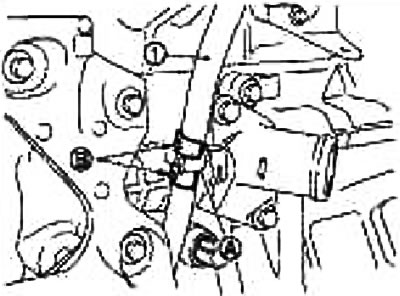
21. After this operation, assembly is carried out in the reverse order of disassembly.